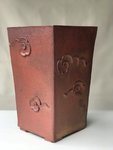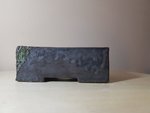Hello and good morning. I have started to make some bonsai pots and need some help getting the right colors and sheen for conifer trees. I have read that they need to be matt or low sheen at best. I have looked at a lot of pottery websites and go about crazy trying to sort out all the types, colors, sheens etc. I am looking for reds, browns, or colors that are acceptable for the conifers. I am using Laguna white and red clay and we are firing at cone 5-6. I have considered using stains verses glaze but have no idea how that might work. Any help would be appreciated. Peter
You are using an out of date browser. It may not display this or other websites correctly.
You should upgrade or use an alternative browser.
You should upgrade or use an alternative browser.
Help needed for coloring conifer pots
- Thread starter August44
- Start date
Peter, I am in no way a potter. But for conifers, the preference is a non-glazed pot of earth tone colored clay.
These colors might start as light as a tan, but they are generally medium to dark brown. Grey is also used.
For finishes, again, a natural smooth finish is the norm. Although some like the “pear skin” of the antique Chinese pots. Bigae makes a burnished finish that is very attractive.
I would do some google searches and look at lots of images.
These colors might start as light as a tan, but they are generally medium to dark brown. Grey is also used.
For finishes, again, a natural smooth finish is the norm. Although some like the “pear skin” of the antique Chinese pots. Bigae makes a burnished finish that is very attractive.
I would do some google searches and look at lots of images.
Thanks for comments Adair. I think I understand the color thing, it's where to get the materials to make the proper color and sheen that I am having a problem with. You mentioned the name "bigae" and burnished finished. Is that a Co. or a person? Thanks, Peter
He’s a potter in Japan. I probably spelled the name wrong.Thanks for comments Adair. I think I understand the color thing, it's where to get the materials to make the proper color and sheen that I am having a problem with. You mentioned the name "bigae" and burnished finished. Is that a Co. or a person? Thanks, Peter
Leo in N E Illinois
The Professor
- Messages
- 11,634
- Reaction score
- 24,363
- USDA Zone
- 5b
Bigei is the more correct English transliteration of his signature chop.
M. Frary
Bonsai Godzilla
Shibui
Imperial Masterpiece
You can obviously put conifers in any pot you like or make any pot and put a conifer into it but unglazed pots are usually used for them. Unglazed pots come in a range of colours as Adair mentions above. I'm not a potter either but I believe the colours come from the clay itself so a white clay will probably not be suitable to make pots for conifers. Some unglazed pots have a shiny surface which I believe is achieved by burnishing (polishing) the partly dry surface.
There may also be oxides and other coloring agents that can be mixed into the clay to affect the final colours - that's really why natural clays have different colours anyway, different combinations of natural oxides and other elements. You'll need to talk with more experienced potters about colours of unglazed pottery.
There may also be oxides and other coloring agents that can be mixed into the clay to affect the final colours - that's really why natural clays have different colours anyway, different combinations of natural oxides and other elements. You'll need to talk with more experienced potters about colours of unglazed pottery.
Mihai
Shohin
Hey @Peter44 . If you can't find clay that fires brown, you have a few choices. One would be oxide washes. Iron and manganese being first and foremost.
Can't help with cone 6 because I only use cone 10 stoneware, but iron depending on quantity will get you either red towards dark brown earthen coloring with greish/black if the temp is really high, and manganese will be dark brownish to black with a metallic sheen if the coat is thick. If you want the standard brown, you can go with an engobe over your white clay body.
Can't help with cone 6 because I only use cone 10 stoneware, but iron depending on quantity will get you either red towards dark brown earthen coloring with greish/black if the temp is really high, and manganese will be dark brownish to black with a metallic sheen if the coat is thick. If you want the standard brown, you can go with an engobe over your white clay body.
Mihai
Shohin
Mihai...great info and just what I was looking for. I will look for some of the product you have mentioned and get to work. Thanks for taking the time to post info and the pictures. I appreciate the help! Peter
Mihai
Shohin
Hey @Peter44. The oxide wash is not really a factor. The water absorbtion percentage of the clay influences the frost resistance. For example, I use a groggy stoneware clay that vitrifies at cone 10, around 1250°C. The absorbtion is around 0.5%, given by the company that produces it. I'm actually looking at a doing some professional frost resistance tests done on my wares with repeated frost-defrost cycles. Finding a lab is difficult tho'.
Gsquared
Shohin
I fire cone 10 reduction as well, but have fired cone 6 oxidation (electric kiln) and have had very good results w oxide stains. My primary is red iron in a thin wash, here’s an example:

Red iron can get very dark if you put it on heavy. Almost the color of cast iron.
This is iron and rutile. Rutile is a flux and will pull out some silica and can sometimes give a light sheen.

But my favorite of all is soda ash. Basically it is just baking soda cooked in the oven, but in a strong solution in water the results are great. Deep rich color but still unglazed surface. It pulls silica out of the clay body and enhances iron in it too. It can be used w glazes too.



Red iron can get very dark if you put it on heavy. Almost the color of cast iron.
This is iron and rutile. Rutile is a flux and will pull out some silica and can sometimes give a light sheen.

But my favorite of all is soda ash. Basically it is just baking soda cooked in the oven, but in a strong solution in water the results are great. Deep rich color but still unglazed surface. It pulls silica out of the clay body and enhances iron in it too. It can be used w glazes too.


Gsguared, great post and pictures. Thank you for taking the time to do that. I love the pots you pictured. Do you sell also? I have Manganese oxide wash, Rutile, and Iron coming next week. I will look for the Soda Ash. Should I assume that is an oxide wash also? I would guess you are mixing your own washes from powder? I bought the concentrated liquid and have to figure how much water to mix with it to get the right colors. They say it does not take very much of the concentrate. I will be in touch. Thanks again. Peter
Brian Van Fleet
Pretty Fly for a Bonsai Guy
Really nice work! The 2nd and 3rd one are very tasty!
Gsquared
Shohin
Soda ash is easy. Take a box of Arm and Hammer, spread it out in a baking tray and preheat the oven to 275. Once the oven it hot, put the soda in the oven, turn it off and let is sit in the hot oven for 50 min. That’s it. You’ve driven one oxygen molecule so instead of sodium bicarbonate, you have sodium carbonate. To put it into a strong solution, you will need to heat the water, not boiling, just hot. As it cools you may get some crystallization. Just heat it up again with one of those heating coils you can put in a cup of tea.Gsguared, great post and pictures. Thank you for taking the time to do that. I love the pots you pictured. Do you sell also? I have Manganese oxide wash, Rutile, and Iron coming next week. I will look for the Soda Ash. Should I assume that is an oxide wash also? I would guess you are mixing your own washes from powder? I bought the concentrated liquid and have to figure how much water to mix with it to get the right colors. They say it does not take very much of the concentrate. I will be in touch. Thanks again. Peter
Smoke
Ignore-Amus
Helps with flatulence too.Soda ash is easy. Take a box of Arm and Hammer, spread it out in a baking tray and preheat the oven to 275. Once the oven it hot, put the soda in the oven, turn it off and let is sit in the hot oven for 50 min. That’s it. You’ve driven one oxygen molecule so instead of sodium bicarbonate, you have sodium carbonate. To put it into a strong solution, you will need to heat the water, not boiling, just hot. As it cools you may get some crystallization. Just heat it up again with one of those heating coils you can put in a cup of tea.
Similar threads
- Replies
- 25
- Views
- 1K
- Replies
- 10
- Views
- 801






